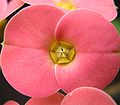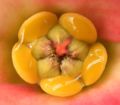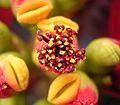Cyathium


A cyathium (Greek kyathion "small cup") is the degenerated , pseudo-flowered and complex, zymous inflorescence of several genera, such as the spurge ( Euphorbia ) and a few others, in subs in the family of the spurge family (Euphorbiaceae), which appears like a single flower .
A hermaphrodite cyathium consists of
- five (rarely four) bracts . These are small, overgrown bracts that form a cup-shaped flower envelope ( involucrum , Greek: envelope). The upper “lobes” (tufted bracts of the male flowers), which are often formed on the inside and often fringed, initially cover the opening of the involucre like the central shutter of a camera. Alternate with these
- five (only terminal) or four, fleshy nectar glands , there are stipules of involuklaren bracts, they are Interfoliarstipeln converted. The two neighboring stipules of two leaves form a nectar-producing gland that is sometimes fused with one another.
- A reduced, mostly bare, stalked female flower (summit flower , gynophore ) standing centrally on the base of the involucre , which often only consists of a triple ovary with three branched styles and is bordered by
- five groups, in winding inflorescences, reduced, mostly bare, often only consisting of a single stamen , stalked male flowers. They stand at the base in the armpits of the involuclear bracts. There may be other small bracts (lacinia, sepal scales).
The cyathia can be actinomorphic or zygomorphic . There can rarely be a small perianth with the flowers . Male, female, and hermaphroditic cyathias are possible.
The flower-like character of cyathia is often brightly colored nectar glands and often their kronblattartigen highlighted (petaloid) appendage. The only under the cyathium of euphorbia , mostly occurring, often strikingly colored, more or less trained pros help or bracts. Together they replace the missing petals of the individual flowers. These lower, mostly paired, often upright and cup-shaped or protruding, special bracts are called cyathophylls .
The following cross-sections through hermaphrodite cyathia illustrate their unusual structure.
Legend:
| b | Bracts, bracts (cyathophylls) |
| i | Perium, involucrum |
| G | Nectar gland |
| ag | Appendage of the nectar gland |
| bo | Tip of the perianth, bractea |
| mf | Male flower, a stalked stamen with two anthers at the top |
| jmf | Immature male flower |
| a | Anthers, anther |
| pmf | Male flower stalk |
| ff | Feminine flower, a short-stalked ovary with the three knotty pistils that bear the stigma |
| O | Ovary, ovary |
| s | Stylus |
| pff | Female flower stem |
The cyathia are rarely single, but mostly in zymous , complex, compound inflorescences of the second order: in cymes , on dichotomously forked stems or in so-called simple cymes with a central cyathium and two lateral cyathia.
In a group of Malagasy species ( E. aureoviridiflora , E. capmanambatoensis , E. iharanae , E. leuconeura , E. neohumbertii , E. viguieri ) there is a tendency to form another pseudanthium from the cymenus . Probably as an adaptation to fertilization by birds , the cyathia have specialized: Most cyathia have upright cyathophylls that protect them but make the nectar glands inaccessible. To compensate for this, there are naked, sterile cyathia between them, the only task of which is to produce nectar.
gallery
The following photos show examples of common forms of inflorescences, cyathia, and their details.
Single cyathium (here a female plant) from Euphorbia mammillaris with nectar drops
Euphorbia stellata inflorescences in so-called simple cymes. The central cyathia are in the male, the lateral cyathia in the female stage.
Simple cymes in Euphorbia sepulta with already wilted central cyathia
Simple cymes in Euphorbia opuntioides with the lateral cyathia in the bud state
In Euphorbia attastoma the red cyathia appear individually or in small groups
In Euphorbia mafingensis , the horseshoe-shaped fused nectar glands imitate carrion in color and smell. There is a pair of green bracts under the cyathium.
In Euphorbia echinulata , too , the striking nectar glands are fused in a horseshoe shape
In Euphorbia globosa , the hollow of the involucrum is clearly visible. The nectar glands have finger-shaped appendages
In Euphorbia xanti , the red-brown nectar glands have white, petal-like appendages
The Christ thorn ( Euphorbia milii ) carries a pair of splayed cyathophylls under the cyathium
Close up of a cyathium from Euphorbia milii . Between the nectar glands, the "tails" protrude over the opening of the involucre.
In Euphorbia neohumbertii , the pair of cyathophylls is wrapped protectively around the cyathia. The sterile and naked cyathia, which only serve to produce nectar, are clearly recognizable
The cyathia of the poinsettia ( Euphorbia pulcherrima ) are surrounded by bright red bracts
The bracts of the Euphorbia epithymoides are bright yellow in color
The cyathia of Euphorbia epithymoides are also bright yellow
The purple bracts of Euphorbia atropurpurea form a striking contrast to the yellow-green nectar glands
The nectar glands of Euphorbia lathyris have two horn-shaped appendages
The solstice spurge ( Euphorbia helioscopia ) shows a shamrock arrangement of cyathia
Euphorbia peplus only has short-lived real leaves and consists almost exclusively of the shamrock inflorescence with many bracts
Web links
- About the genus Euphorbia at euphorbiaceae.org, accessed June 2, 2018.
Individual evidence
- ^ A b Gerhard Prenner, Paula J. Rudall: Comparative ontogeny of the cyathium in Euphorbia (Euphorbiaceae) and its allies: exploring the organ-flower-inflorescence boundary. In: Am. J. Bot. 94 (10), 2007, pp. 1612-1629, PMID 21151828 .
- ↑ G. Prenner, St. Hopper, P. Rudall: Pseudanthium development in Calycopeplus paucifolius, with particular reference to the evolution of the cyathium in Euphorbieae (Euphorbiaceae-Malpighiales). In: Australian systematic botany. 21 (3), 2008, pp. 153-161, doi : 10.1071 / SB08010 , online (PDF) at researchgate.net.
- ↑ J. Horn, B. van Ee, JJ Morawetz et al .: Phylogenetics and the evolution of major structural characters in the giant genus Euphorbia L. (Euphorbiaceae). In: Molecular phylogenetics and evolution. 63, 2012, pp. 305-26, doi : 10.1016 / j.ympev.2011.12.022 , online (PDF) at researchgate.net, accessed on May 26, 2018.
- ^ Veit M. Dörken: Euphorbiaceae - milkweed plants (Malpighiales). online (PDF) at Univ. Konstanz, accessed on May 26, 2018.
- ↑ J. Molero, AM Rovira: Euphorbia L. subsect. Esula (Boiss. In DC.) Pax in the Iberian Peninsula. Leaf surface, chromosome numbers and taxonomic treatment. In: Collect. Bot. (Barcelona), 21, 1992, pp. 121-181.
- ↑ H. Reichert, Th. Gregor, L Meierott: Euphorbia saratoi (= E. podperae, E. pseudovirgata auct., E. virgata var. Orientalis, E. virgultosa) - a neophyte of unclear origin in Central Europe and North America. In: Kochia . 11, 2018, online (PDF; 5.6 MB) at researchgate.net, accessed on May 27, 2018.
- ^ Karl Schumann : Internship for morphological and systematic botany. Fischer, 1904, Salzwasser, 2013, ISBN 978-3-8460-2258-0 (Reprint), pp. 261-264, limited preview in the Google book search.
- ^ Focko Weberling : Morphology of Flowers and Inflorescences. Cambridge Univ. Press, 1989, ISBN 0-521-25134-6 , pp. 303-308.
- ↑ Die Cyathien der Euphorbia on euphorbia.de, accessed on May 26, 2018.





















